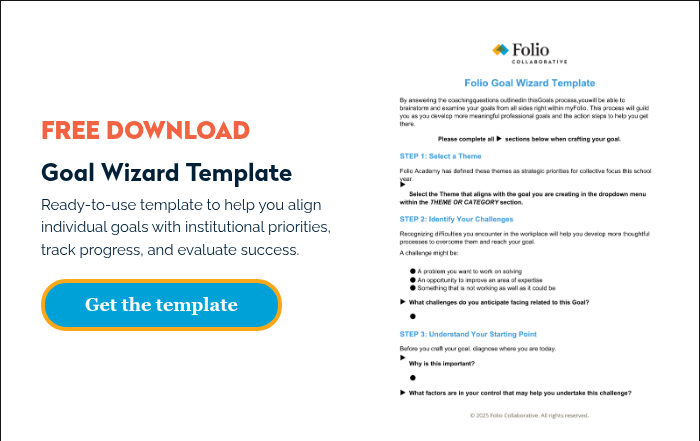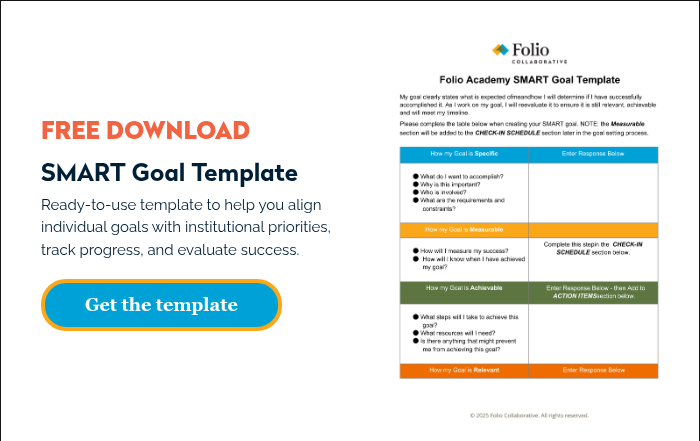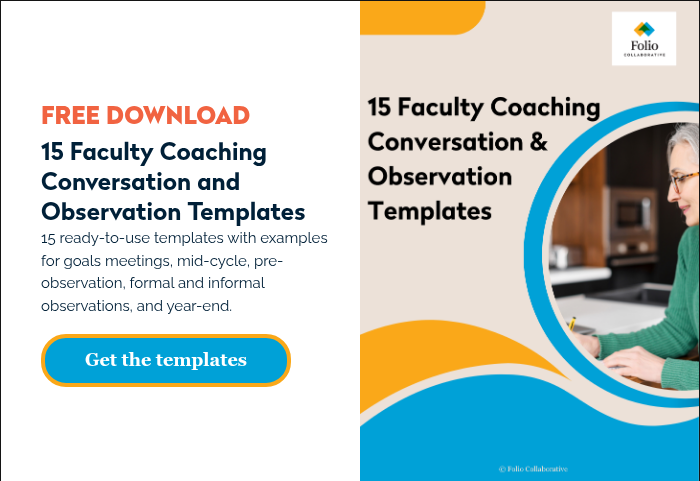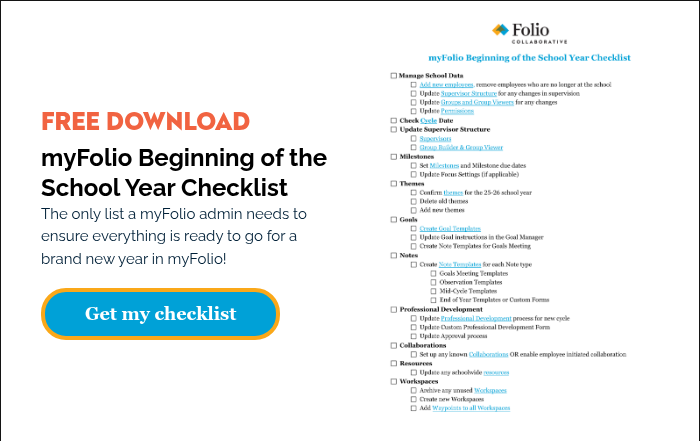I am excited to share how I use the summer months to plan and prepare for our year-long process for professional growth at Cushing, leveraging the Folio platform and the summer updates. I’ll identify the key features that guide our approach at Cushing, with an emphasis on the impact we have seen - and aim to see - for our faculty and for our learners.
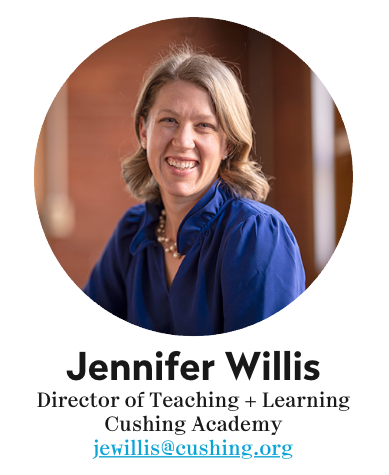
Folio, and the Folio community, have served as helpful guides in shaping our approach to professional growth and evaluation here at Cushing. I always try to join as many of these calls as I possibly can and I am definitely a fan of registering in order to get the video and slides later. While this written format lacks some of the interactive energy I crave, hopefully the content can still be of use. Whatever version of this conversation you are joining I applaud you for your interest in doing the front end work to support your teachers and department heads in the upcoming year.
Proactive Summer Planning is Crucial

This is a photo from Cushing’s Summer Session, which runs for five weeks each year. I do not have a role with the summer session program but I am in my office throughout the summer.
I do my best to leverage these quiet days because I know that once September is here…
...my daily pace accelerates back to full-throttle, getting into classrooms for observations, supporting new faculty members, and helping students find joy and success in the classroom.
The more intentional I can be during the summer, the more meaningful the experience can be for our teachers and department heads once the business - and the busy-ness - of the academic year gets underway.
I am headed into my ninth year as a Folio administrator, seven years here at Cushing and two years at my previous school - and at this point I aim to start the year with a flexible structure that serves as a roadmap while also allowing for whatever unexpected detours will inevitably come our way.
Flexibility and Realistic Expectations are Key
For almost a decade I have been crediting Folio saying, “We believe everyone has room to grow, every year.”
This is a mantra that guides our goal setting process each fall, but it’s also something that I keep in mind as we aim to improve the PG+E system each year.
My top priority is designing an approach that I feel we can deliver. We have added to and tweaked our approach each year and these summer months have been some of the most important time to do the necessary proactive planning and to create the tools that we will need throughout the year.

By August in-service meetings we have a drafted timeline for our process, which we review with Academic Department Heads and adjust, as needed. Every single year we have had to adjust something - observation timelines, mid-cycle meeting note dates. I think I would honestly be a little worried if there was a year when we didn’t make any adjustments.
We want to build something that feels realistic and can have a level of accountability, but our Department Heads are teaching full course loads and balancing afternoon activities and residential life responsibilities - AND they have families and they need to sleep!
From the start of the year we message out that while we do want them to honor deadlines, the higher priority is engaging in meaningful conversations and classroom visits with their department members. I struggled to find the actual quote but I know there is something Folio says about “The Conversation Matters!” and I want this to feel like something we really honor.
Our Goal Setting deadline reflects the date from the August in-service goal setting session. Some folks continued to work on their goals after that but others stuck with what they entered as we worked together in our library that day. Our academic department heads facilitate the PG+E conversations so faculty met with their department head in September - and into early October - to talk about their goals and department heads aimed for that October 4th date to get notes submitted into Folio.
Each fall every teacher has two planned observations - one by their department head and one by either myself or my colleague in the Academic Office, Dave Stone, who serves as Dean of Faculty. Dave and I end up with about 25-26 observations each fall so we don’t hit that November 1 target, but we ask department heads to do their best and we all work to prioritize new - or newer - faculty as our earlier observations.
We aim to have mid-cycle meetings by the start of our Winter Break in December, with the understanding that those first days back in January can also be a really useful time to check-in and so we are very flexible there.
May is a blur every year and we have set our end of year meeting milestone for someone within the first week or 10 days of May in an effort to get those conversations scheduled before we tip too far into AP Exams and all of the end of year traditions and celebrations. We definitely have department heads who end up meeting with returning faculty during our June In-Service meetings, which is totally workable.
What Are My Top Priorities This Summer?

One of the things I have tried to get better at is projecting out how our faculty meeting rotation will work out in the fall semester. We have a three-week rotation that loosely cycles through Full Faculty, New Faculty, and Department meetings. This can help inform our milestone deadlines and get me looking at that larger calendar with an eye toward when we should set initial Milestone deadlines.
It is helpful to have a department meeting about a week before we hope observations are done so that Department Heads have a clearly scheduled time to finalize or adjust any remaining classroom observations.
Fostering a Culture of Growth and Collaboration
 In the summer of 2022 we started a new practice of developing “Home Groups” for our faculty meetings, which we use for our August and June In-Service meetings as well as a few additional faculty meetings throughout the year. Home Groups don’t necessarily connect directly to Folio - although I feel like I stole the idea from a Folio call at some point - but Home Groups do connect to our larger efforts with building interdisciplinary connections among our faculty members and promoting conversations about teaching. The groups each have one academic department head and are loosely organized to have a combination of departments and a mix of new and veteran faculty members.
In the summer of 2022 we started a new practice of developing “Home Groups” for our faculty meetings, which we use for our August and June In-Service meetings as well as a few additional faculty meetings throughout the year. Home Groups don’t necessarily connect directly to Folio - although I feel like I stole the idea from a Folio call at some point - but Home Groups do connect to our larger efforts with building interdisciplinary connections among our faculty members and promoting conversations about teaching. The groups each have one academic department head and are loosely organized to have a combination of departments and a mix of new and veteran faculty members.
I start to reshape these groups over the summer and, despite my initial concerns about what I thought may feel like “assigned seating” the feedback has been very positive. Last year we started a peer observation model, which we call Teaching Triangles, and we worked to align those Teaching Triangles with our home groups as much as we possibly could. Building both groups has become a summer project that, while not necessarily part of our Folio system, is a necessary part of our PG+E system - and one that I’ll circle back to as it relates to tools like observation notes and collaborations.
Strategic Use of myFolio
We do goal setting each year, and typically it falls as the final session of our full faculty in-service meetings. We have started to set the expectation that everyone will upload at least one goal into Folio before that session ends. This year we added some initial goal setting to our June meetings, which we connected to the structured review of student survey feedback. Many of our faculty members went into the summer months with some sense of what their professional growth goal might look like for the upcoming academic year. Some even planned to use the summer to begin working on that goal, but this certainly wasn’t a requirement.
The shift away from the Goal Wizard in Folio isn’t going to have a big impact for us - we have faculty move through a goal setting process (which I had worked to align with the Goal Wizard in order to keep things as simple as possible) but having a little more freedom in that initial brainstorming and discussion of goals within our home groups will be great. I built out the in-service slides over the summer to guide our goal setting practice which, as I mentioned, includes loading their goal - or goals - into Folio. The process for getting folks into the goal setting mindset shifts year to year but we always protect about 45-60 minutes for this process during In-Service.
This year we are in the early phases of a new strategic plan and department heads have been working to articulate departmental vision statements over the last few months. I started creating some department-specific goal templates this month as we will ask faculty members to have at least one of their professional growth goals connected to some aspect of their departmental vision statement. I also added a new “theme” for each department, because I was inspired by someone on the call I joined in June who was describing her approach to data analysis in Folio.
We haven’t really used themes or categories in our goal setting process but I think this will be a great way to leverage that tool a bit more intentionally and we’ll build this into our August in-service time - pretty much anytime I introduce a new feature in Folio we roll it out in person and I try to have a screencast that I can share with folks later, as needed.
Something like using a template isn’t terribly tricky but there’s no way to enter the school year without hitting that point of cognitive overload or saturation so anything new needs special attention!
Last year I was really happy that we were able to tie our peer observation model - Teaching Triangles - to Folio by having faculty use a Conversation Note to reflect on their visit. I created my first conversation Note Template for this purpose last year. I am particularly excited about the new opportunities that Folio has created for Collaborations for the year ahead.
We have previously not done any work with collaborations or workspaces, largely in an effort to promote a sense of comfort in terms of what aspects of a teacher’s Folio page a colleague can see. With the ability for users to manage invitations and my ability as the administrator, I plan to build this process into an early faculty meeting once we have confirmed our Teaching Triangles, asking folks to view and manage what colleagues can see. I am hopeful that we can build out the Teaching Triangle program to promote more connection and more collaboration.
The other big priority for me this summer is leveraging the ability to specify five different types of observation forms this year and I hope to build out a template for each type. Right now we are thinking about one for each of the formal observations we do - one by the academic office and one by the department head. We are also trying to decide between using a conversation note for the Teaching Triangles or seeing if that might fit better in the Observation category. I will make a quick template (maybe I Like, I Wish, I Wonder) for informal walkthroughs, which we try to do during the opening weeks of the year - and will probably have our fifth type be for when New Faculty Mentors visit during that first month of the year.
Our new faculty mentor program provides a year-long structure that is intended - as best we can - to avoid the firehose experience at the start of the year. I like to have a clean and clear Roll Call page for myself, and I am excited about the ability to assign these different types of Observations this year.
Impact on the School Community
In terms of impact - I think Folio has been a game changer for us in the effort to just get folks in and out of classrooms more - helping normalize and celebrate visits from department heads, administrators, and now from peers.
 Teaching can be such a solitary - and sometimes isolating - experience so building in the collaborative component is energizing and affirming.
Teaching can be such a solitary - and sometimes isolating - experience so building in the collaborative component is energizing and affirming.
It is incredibly powerful and important for our students to see this kind of connection and collaboration among the adults in their community.
Students are always curious when there is a visitor in their space and I think we have built - and continue to build - a really healthy culture of professional growth.
In an early conversation about Folio with a colleague at my previous school there was a question about other ways to track whether or not we were completing annual observations and of course there are! What Folio has allowed us to do goes way beyond that, aiming to build a culture where growth, reflection, and conversation are structured and celebrated. A lot of that comes down to the Folio-ism that I hold most closely:

CONTINUE YOUR LEARNING
Learn how Phoenix Country Day School shifted their professional development model from an evaluation system to a 3-year growth and renewal cycle.


